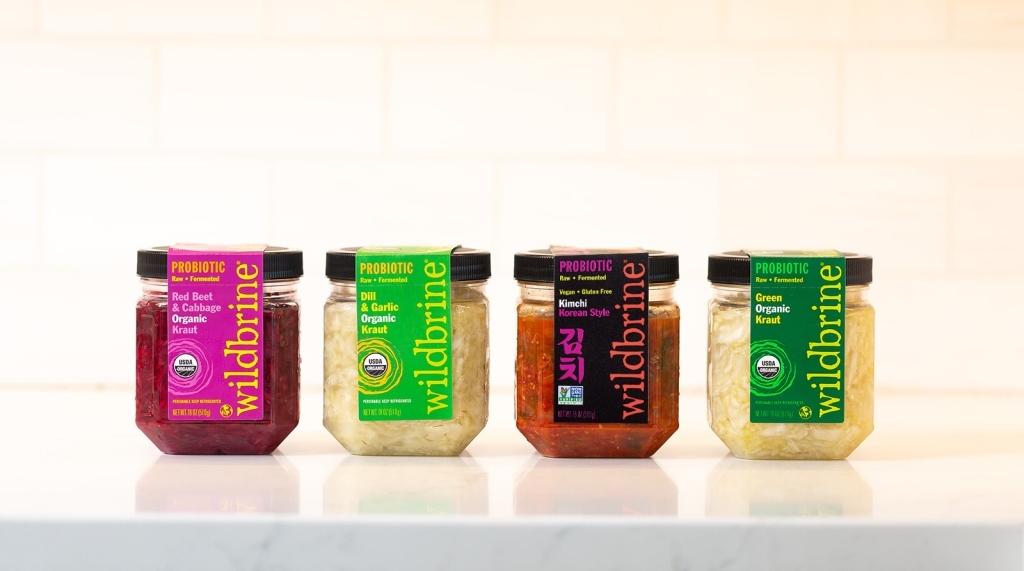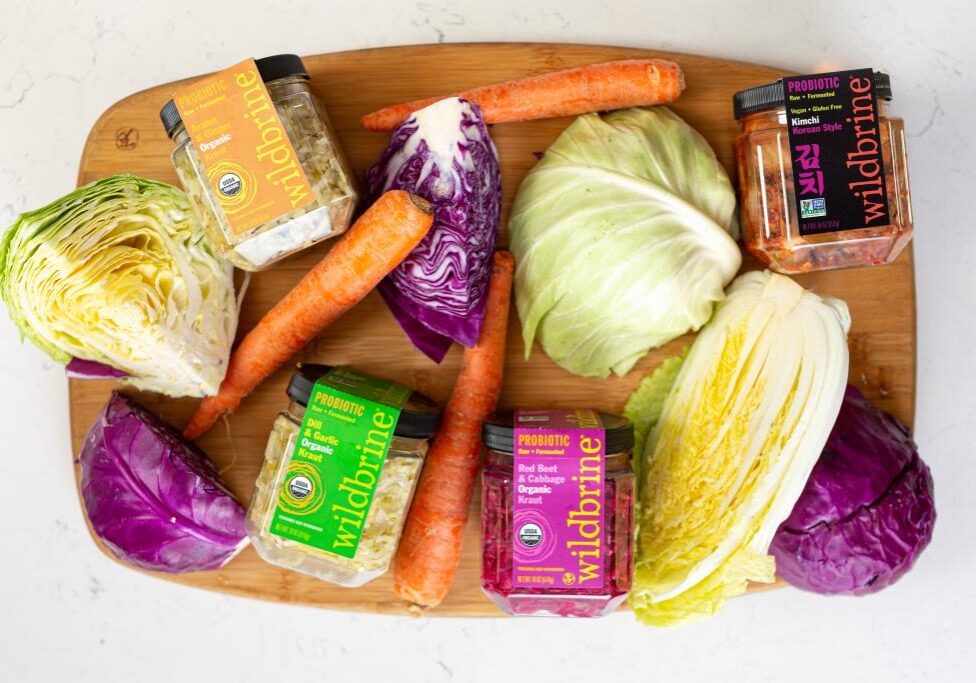Red cabbage has one important nutritional extra over the green cabbages: its red pigment. The green types wildbrine uses for our unpasteurized fermented products include the Asian favorite napa cabbage and the familiar green cabbage heads the size of soccer balls. They are all packed with flavor and nutrition, from potassium and Vitamin A to Folate and Vitamin K. But do you think red cabbage’s nutrition wins the whole race? Read on.
We reserve red cabbage for two wildbrine products: Raw Organic Red Cabbage and Organic Red Beet and Cabbage sauerkrauts. The red pigment is a bioflavonoid called anthocyanin—the same compound that makes grapes, strawberries, raspberries, and many other plants red–and boy is it good for you.
To understand why, let’s visit the atomic level for a moment. There’s an element that runs around in our bodies looking for electrons—it’s the great electron acceptor called oxygen. As it scavenges electrons from our cells, the oxygen combines with and damages those cells. We all know what happens when oxygen combines rapidly with a substance. We call that “burning.” When it happens in a more controlled way, we call that “inflammation.” In either case, it’s a cause of disease as cells are damaged and subsequently malfunction.
Anthocyanins, however, are great electron donors, meaning they can donate electrons to other atoms, including those hungry oxygen atoms. As they roam the body, they donate electrons to oxygen, rendering the oxygen’s electron system full and complete and therefore unable to burn or inflame the tissues we need for good health. That’s why anthocyanins are called antioxidants. They are not the only, or even the primary, antioxidants in our bodies, but they do their share of this protective work that keeps us healthy. Research has found that anthocyanins possess antidiabetic, anticancer, anti-inflammatory, antimicrobial, and anti-obesity effects, as well as helping to prevent cardiovascular disease.
Napa, Green and Red Cabbage Nutrition
The powerful nutrition of red and green cabbages is fairly equal and plenty potent. Here’s a quick rundown of how the three cabbage types used in wildbrine sauerkrauts stack up.
| Nutrient | Red Cabbage | Green Cabbage | Napa Cabbage |
| Calories (kcal/gm) | 31 | 25 | 13 |
| Protein (gm) | 1.43 | 1.28 | 1.5 |
| Total fat (gm) | 0.16 | 0.1 | 0.2 |
| Carbohydrate (gm) | 7.37 | 5.8 | 2.18 |
| Dietary Fiber (gm) | 2.1 | 2.5 | 1.0 |
| Calcium (mg) | 45 | 40 | 105 |
| Vitamin C (mg) | 57 | 35.6 | 45 |
| Magnesium (mg) | 12 | 16 | 19 |
| Potassium (mg) | 170 | 243 | 252 |
| Vit. A (IU) | 1116 | 98 | 4468 |
| Vit. K (mcg) | 38.2 | 76 | 45.5 |
| Folate (mcg) | 18 | 43 | 66 |
(Source: BotaPedia.com – Botanical Encyclopedia by Hesham A. Gawad, PhD)
The green cabbage found in most supermarkets was developed from wild brassicas that grow across Europe and have been cultivated since ancient times. Long before refrigeration, cabbage was kept wholesome by shredding and fermenting it in brine. Lactic acid bacteria preserved it and turned the raw cabbage into delicious, tangy sauerkraut—a German term meaning sour herb—that became a staple from Russia across Western Europe.
Be sure to read our post about how wild fermentation works.
The History of Cabbage
Red cabbage was originally a wild brassica from southern Europe with a purplish color. Like its green sister, it was developed into tightly-packed heads of leaves over the centuries leading up to the Middle Ages. Napa cabbage came about in the 16th Century in Europe when strains that produced crinkled leaves were selected for special cultivation.

Napa cabbage is most likely an unplanned cross between a turnip and pak-choi that happened near Beijing centuries ago. It’s become the main vegetable in a Chinese-style sauerkraut that’s popular throughout northeastern China. It has also become the chief ingredient in Korea’s most popular form of kimchi, served at just about every meal in that country.
The fermented cabbage sauerkrauts and vegan kimchis from wildbrine are packed with a probiotic punch that supports a healthy gut microbiome, and they go “beyond delicious.” What does that mean? It means they not only taste great, they are addictive, too. Your meals have an added level of satisfaction when you know you’re feeding the gut bacteria that promote your good health, as well as adding something super scrumptious to the other foods on your plate.
For instance, next time you make a grilled cheese sandwich, brighten it up visually, and flavor-wise, with some delicious fermented red cabbage nutrition. Get the recipe. And explore wildbrine’s sauerkraut.
